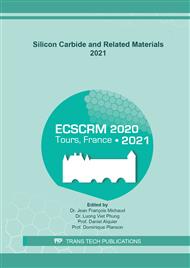p.175
p.180
p.185
p.190
p.195
p.204
p.209
p.214
p.219
The Development of Monolithic Silicon Carbide Intracortical Neural Interfaces for Long-Term Human Implantation
Abstract:
Silicon Carbide (SiC) has been demonstrated as both a bio- and neuro-compatible wide-band-gap semiconductor with a high thermal conductivity and magnetic susceptibility and may be potentially compatible with human brain tissue. Two single-crystal, solid-state forms of SiC have been used to create monolithic intracortical neural implants (INI) without using physiologically exposed metals or polymers, thus eliminating many known reliability challenges in-vivo through a single, homogenous material. Amorphous SiC (a-SiC) was used to insulate 16-channel functional INI and the electrochemical and MRI compatibility (7T) performance were measured. 4H-SiC interfaces were fabricated using homoepitaxy,alternating epitaxial films of n-type and p-type forming an isolating PN junction which prevents substrate leakage current between the 16 adjacent electrodes and traces fabricated which were formed using deep-reactive ion etching (DRIE). 3C-SiC interfaces were fabricated in a similar fashion, but the epitaial conductive layers were grown on on both bulk crystalline (100) silicon and SOI wafers. In both cases a conformal coating of a-SiC was used as the top-side insulator and windows opened using RIE to allow electrochemical interaction. Electrochemical charaterization achieved through electrochemcial impedance spectroscopy (EIS) and cyclic voltammetry (CV) indicates performance on par, or exceeding, that of Pt reference electrodes with the same form fit. While magnetic resonance imaging (MRI) is an essential, non-contact method used to investigate issues with the nervous system, the high field MRI (e.g., 3 T and higher) necessary for proper diagnosis can be a safety issue for patients with INI due to inductive coupling between the powerful electromagnetic fields and the implanted device. This results in having to use lower electromagnetic field power (less than 1.5T), and therefore lower resolution, which hinders diagnostic prognosis for these patients. In this work the MRI compliance of epitaxial, monolithic SiC INI was studied. The specific absorption rate (SAR), induced heating, and image artifacts caused by the portion of the implant within a brain tissue phantom located in a 7 T small animal MRI machine were estimated and measured via finite element method (FEM) and Fourier-based simulations. Both the simulation and experimental results revealed that free-standing 3C-SiC films had no observable image artifacts compared to silicon and platinum reference materials inside the MRI at 7 T while FEM simulations predicted an ~30% SAR reduction for 3C-SiC compared to Pt. These initial simulations and experiments indicate a SiC monolithic INI may effectively reduce MRI induced heating and image artifacts in high field MRI.
Info:
Periodical:
Pages:
195-203
Citation:
Online since:
May 2022
Keywords:
Permissions:
Share:
Citation:


